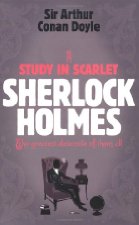Review: ‘A Study in Scarlet’ by Sir Arthur Conan Doyle
Author: Sir Arthur Conan Doyle
Published: Headline Review, 2006, pp. 164
Genre: Classic mystery fiction
Blurb: Arriving in the wilderness of London and in need of lodgings, Dr John Watson finds himself living at 221b Baker Street with one Sherlock Holmes. When a corpse is discovered in a derelict house Watson, fascinated by his brilliant, eccentric companion, is soon drawn into Holmes’ investigations. There’s no sign of a struggle, no wounds on the body, yet scrawled in blood across the walls is the word RACHE — revenge. Watson is baffled, but for Holmes the game is afoot…
Where, when and why: In The Thirteenth Tale the doctor prescribes Sherlock Holmes to the narrator as the antidote to reading too much sensational fiction. Given my own recent reading habits I thought that I might enjoy the change of pace and style found in these stories as much as Margaret did, so I ordered the first one and started reading it as soon as it arrived in the office. It also just sneaks in before the deadline for my last read for the R.I.P Challenge, qualifying me for Peril the First.
What I thought: Reading this book was a lot like watching an episode of a detective show on television: it was fast-paced, entertaining and I found it impossible to work out what had happened before it was finally revealed. Specifically, it reminded me of ‘The Mentalist’ because of the way that Sherlock Holmes solved the mystery simply with close observation and knowledge of human nature, rather than with complicated science which always feels a bit like cheating to me.
I thoroughly enjoyed the character of Holmes, treading the precarious line between madness and genius and appearing to stray into the former more often than not. The story seems to be more about his madcap antics than the process of solving the mystery, as his smug reticence when questioned about what he knows prevents anything being given away, but I found this a clever way of drawing out the suspense in a very short story. Watson’s staid character and narrative style seem particularly appropriate as a counterpart to Holmes, not least because he seems just as baffled by proceedings as I was.
Readers seem to be divided on the efficacy of the long diversion towards the end of the book which explains the mystery, but I thought that it works and found it to be a welcome change. The switch from detective story to personal history slows the pace of the narrative down and allows for some interesting development of the character of the murderer. I liked the fact that the reader is provided with a more in depth explanation for the motives behind the murderer’s actions which changes the reader’s perspective. I definitely look forward to carrying on with this series.
Where this book goes: As I enjoyed this book it looks as though I may end up starting a Sherlock Holmes collection, so naturally this one stays where it is.
Tea talk: This book was read entirely on the return train journey of the one on which I read Twist of Gold, so once again there was no tea. I’m slowly working my way through some much longer books though, and there’s plenty of tea talk to accompany those.

